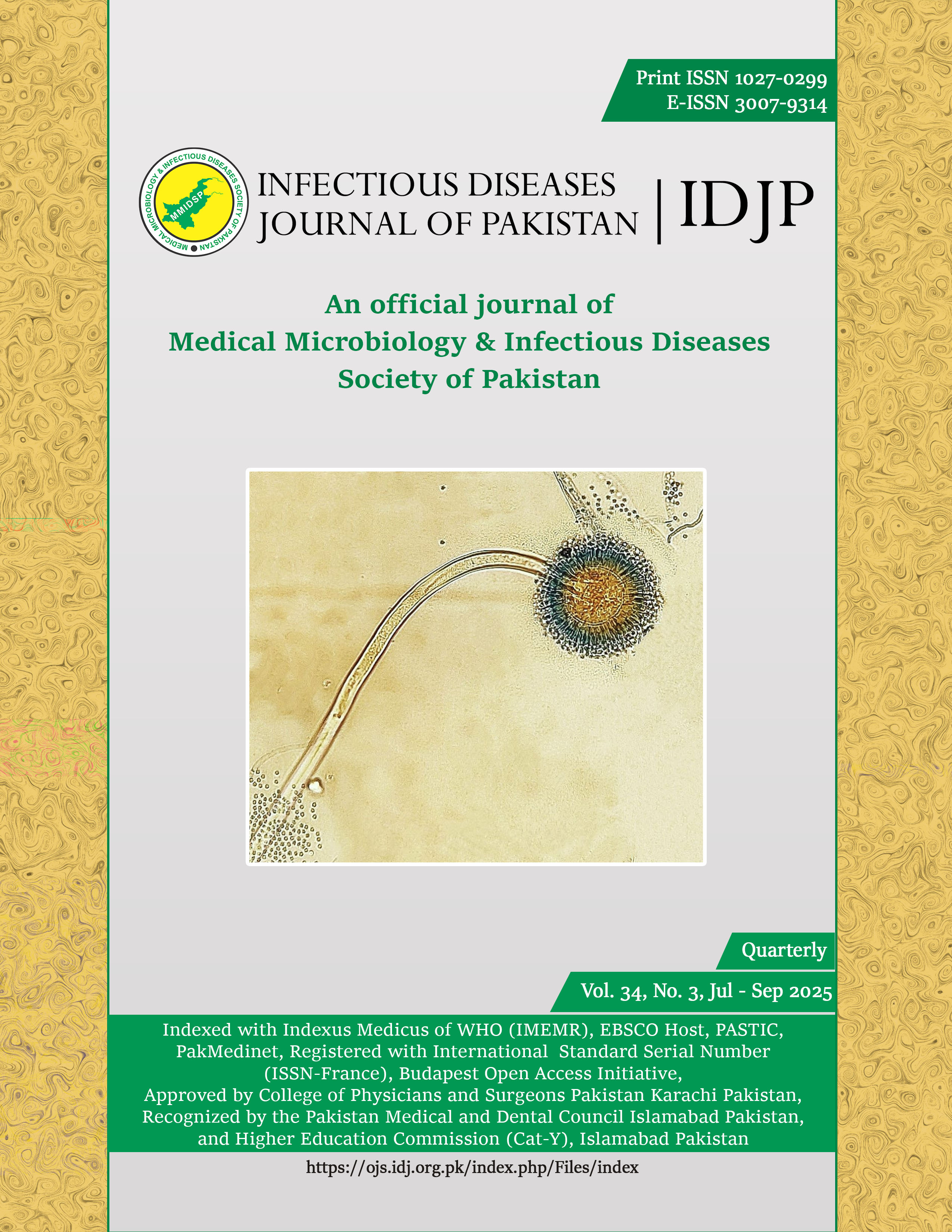Sero-prevalence of syphilis, risk factors and clinical characteristics among blood donors in a tertiary care hospital in Karachi, Pakistan
DOI:
https://doi.org/10.61529/idjp.v34i3.405Abstract
Background: Transfusion poses a risk of transfusion-transmitted infections. Our aim is to evaluate blood donors who test positive for syphilis in order to confirm the diagnosis, assess clinical features and establish risk factors.
Material and Methods: A cross-sectional study was conducted from June to December 2024 at Sindh Institute of Urology and Transplantation (SIUT), Karachi. All blood donors who tested positive for treponemal antibodies by chemiluminescence immunoassay (TP-CMIA) were evaluated at the Infectious Diseases (ID) clinic between June to December 2024. History, examination and confirmatory testing with rapid plasma reagin (RPR) and Treponema pallidum hemagglutination (TPHA) tests were performed.
Results: A total of 20,685 donors were screened, and 374 (1.8%) tested positive on TP-CMIA. Of 374, 152 (40.6%) presented to the clinic of whom 91 (60%) were confirmed to have syphilis. Of these, 61(40%) were RPR negative but TPHA positive. Mean age was 33.5 ± 7.93, and 150 (98.6%) were male. Pre-marital or extra-marital sexual relations were significantly associated with confirmed syphilis [OR 9.06, 95% CI (3.9-20.8)].
Conclusion: Sero-prevalence of syphilis in blood donors is 1.8% at our centre. It is of concern that 40 % of donors with confirmed syphilis were negative for RPR, as this is used for initial screening at many blood donation centres. Pre-marital and extra-marital high-risk sexual activities were highly associated with confirmed syphilis. A thorough and detailed history can effectively identify and exclude high-risk donors for blood donation, providing a cost-effective approach to screening.
Keywords: Syphilis, Screening, Blood donors
References
Greinacher A, Weitmann K, Schonborn L, Alpen U, Gloger D, Stangenberg W, et al. A population-based longitudinal study on the implication of demographic changes on blood donation and transfusion demand. Blood Adv. 2017; 1(14): 867-74. DOI: https://doi.org/10.1182/bloodadvances.2017005876
Cao WW, Zhou RR, Ou X, Shi LX, Xiao CQ, Chen TY, et al. Prevalence of hepatitis B virus, hepatitis C virus, human immunodeficiency virus and Treponema pallidum infections in hospitalized patients before transfusion in Xiangya hospital Central South University, China from 2011 to 2016. BMC Infect Dis. 2018; 18(1): 145. DOI: https://doi.org/10.1186/s12879-018-3051-7
Javed SO, Saleem A, Sahito AM, Hasan MM. Transfusion transmitted infections: A present-day danger for Pakistan. Am J Trop Med Hyg. 2022; 106(5): 1311-4. DOI: https://doi.org/10.4269/ajtmh.21-1136
Chen T, Wan B, Wang M, Lin S, Wu Y, Huang J. Evaluating the global, regional, and national impact of syphilis: results from the global burden of disease study 2019. Sci Rep. 2023; 13(1): 11386. DOI: https://doi.org/10.1038/s41598-023-38294-4
Saba N, Nasir JA, Waheed U, Aslam S, Mohammad I, Wazeer A, et al. Seroprevalence of transfusion-transmitted infections among voluntary and replacement blood donors at the Peshawar regional blood centre, Khyber Pakhtunkhwa, Pakistan. J Lab Physicians. 2021; 13(2): 162-8. DOI: https://doi.org/10.1055/s-0041-1729485
Jalbani A, Jamal D, Waheed S, Nihal A. The annual prevalence of syphilis among blood donors of regional blood centers of Sindh: A study conducted by the Sindh blood transfusion authority to evaluate the infectious rate of syphilis among blood donors. Professional Med J 2024; 31(08):1135-1139. DOI: https://doi.org/10.29309/TPMJ/2024.31.08.8227
Arshad A, Borhany M, Anwar N, Naseer I, Ansari R, Boota S, et al. Prevalence of transfusion transmissible infections in blood donors of Pakistan. BMC Hematol. 2016; 16: 27. DOI: https://doi.org/10.1186/s12878-016-0068-2
Nawaz Z, Rasool MH, Siddique AB, Zahoor MA, Muzammil S, Shabbir MU, et al. Prevalence and risk factors of Syphilis among blood donors of Punjab, Pakistan. Trop Biomed. 2021;38(1):106-10. DOI: https://doi.org/10.47665/tb.38.1.019
Tiecco G, Antoni DM, Storti S, Marchese V, Foca E, Torti C, et al. A 2021 Update on syphilis: Taking stock from pathogenesis to vaccines. pathogens. 2021; 10(11): 1364. DOI: https://doi.org/10.3390/pathogens10111364
Ghafoor T, Shabbir N, Mehmood A, Lodhi R, Rathore MA, Fatimah S. Screening of syphilis using the reverse algorithm and its trends among healthy/asymptomatic blood donors: A regional transfusion centre study from Northern Pakistan. Pak Armed Forces Med J. 2024; 74(2): 562-5. DOI: http://dx.doi.org/10.51253/pafmj.v74i2.10260
Henao-Martinez AF, Johnson SC. Diagnostic tests for syphilis: New tests and new algorithms. Neurol Clin Pract. 2014; 4(2): 114-22. DOI:https://doi.org/10.1212/01.cpj.0000435752.17621.48
Ortiz DA, Shukla MR, Loeffelholz MJ. The traditional or reverse algorithm for diagnosis of syphilis: Pros and Cons. Clin Infect Dis. 2020; 71(Suppl 1): S43-S51. DOI: https://doi.org/10.1093/cid/ciaa307
Cohn CSD, Johnson M, Susan T. Katz, Louis M. Technical Manual, 20th Edition. Available from: https://ebooks.aabb.org/pdfreader/technical-manual-20th-edition50155278
Papp JR, Park IU, Fakile Y, Pereira L, Pillay A, Bolan GA. CDC Laboratory recommendations for syphilis testing, United States, 2024. MMWR Recomm Rep. 2024;73(1):1-32. DOI: https://doi.org/10.15585/mmwr.rr7301a1
Hojnoski CE, Kieffer JW, Casey TM, Osuna AB, Casleton BG, Okulicz JF, et al. Follow-up of military blood donors who test positive for syphilis. Sex Transm Dis. 2023; 50(10): 652-5. DOI: https://doi.org/10.1097/olq.0000000000001836
Mittal K, Kaur P, Kaur R, Kaur G, Parmar A, Sharma S. Trends in syphilis seroreactivity among blood donors: A 17-year retrospective analysis and follow-up at a tertiary care hospital. Transfus Apher Sci. 2025; 64(2): 104068. DOI: https://doi.org/10.1016/j.transci.2025.104068
Augustine M, Mahambare A, Mallya MV, Jose M, Pinto M. Syphilis reactivity in blood donors and their response rate – A Study from 'Westernized” Western India and the Need of the hour for a structured screening methodology. Global J Transfus Med. 2022; 7(2): 190-5. DOI: https://doi.org/10.4103/gjtm.gjtm_45_22
Downloads
Published
How to Cite
Issue
Section
License
Copyright (c) 2025 Rohama Samar, Dr Sunil Kumar Dodani , Dr. Javeria Qureshi , Dr. Hira Moin , Dr. Sanjay Kumar Badlani

This work is licensed under a Creative Commons Attribution-NonCommercial 4.0 International License.



